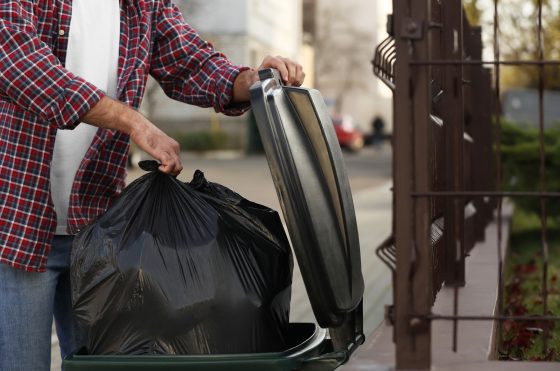Let’s be aware of health and safety for workers who are at risk of sprains, strains, and other injuries while collecting residential garbage and recycling.

Photo credit: Gettyimages.ca/Liudmila Chernetska
Not everyone has the same way of “taking out the garbage.” Different jurisdictions use different methods for collecting garbage, as well. But one thing all garbage pick-up locations have in common is that they are all workplaces.
As residents, we need to know how to keep work safe for garbage collection teams. The rules for this are set by local governments, who are responsible for preventing and disposing of solid waste for homes and businesses. (See more information on Garbage from the B.C. government.)
Back in early summer, I saw this notice from the City of Cranbrook reminding residents to look out for the safety and well-being of their garbage collection team.
To reduce risk of injury to garbage collection teams, residents are asked to:
- Keep the area around where you place your garbage containers for collection clear of obstructions or tripping hazards.
- Make sure that plastic garbage bags are securely closed at the top and are strong enough to withstand normal handling and lifting by our collection team. Bags or containers must also not weigh more than 20 kg (44 lb.) each.
- Ensure no loose garbage or open bags are left out on your collection day.
Keeping collection areas clear to prevent injuries
I contacted Chris Zettel, Corporate Communications Officer for the City of Cranbrook, to find out more about why they reached out to residents with this safety reminder. Chris said, via email: “We had a handful of staff require some leave time or short-term disability due to injuries, including in our garbage collection team.”
“We want our staff to be safe in their work environment, and our residents do play an important role in that overall safety component,” Chris said. “We simply asked our residents to take a few minutes and ensure that areas around where their garbage is placed for pickup is clear of all obstructions, and that bag weight limits are respected, as the role of collecting garbage requires repetitive and often heavy lifting.”
The most common injuries to workers who collect garbage in B.C. include overexertion; falls from height; slips and trips; and “struck by” incidents. Employers are responsible for assessing risks to identify hazards that may put workers at risk. As garbage collection technology improves, it’s essential to review risk assessments when introducing new equipment, materials, or work processes.
See WorkSafeBC’s webpage Garbage & recycling for more health and safety information and resources for work in the garbage and recycling industry. Also see my post Sorting out workplace safety in the waste and recycling industry, about safety for workers using new products, procedures, and technologies to process waste.
Thank you to Chris — and to everyone providing such important service in the garbage and recycling collection industry.


